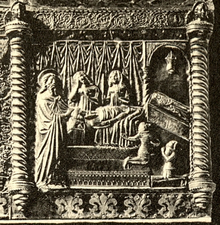Kotromanić dynasty
| Kotromanić Котроманић | |
|---|---|
Despot of Serbia | |
| Dissolution | c. 1500 |
| Deposition | 25 May 1463 |
The House of Kotromanić (
Origins
The origin of the Kotromanić family is unclear. The earliest mention of the name itself is from 1404, when the officials of the
The first Bosnian ruler who is known for certain to have belonged to the Kotromanić family is
History
Consolidation and rise
Prijezda I's realm was significantly smaller than Ninoslav's, the northern regions of
Besides Stephen I, Prijezda I had two more sons,

By 1314 Stephen had been succeeded by
Kingship
Stephen II died in September 1353. His brother Vladislav was excluded from the succession for reasons unknown, and Stephen was succeeded directly by
The royal authority weakened after Tvrtko I's death but the

In April 1398 Helen was dethroned in favour of
Tvrtko II (r. 1420–1443) deposed Stephen Ostojić in 1420, and the latter appears to have died in exile soon afterwards. In 1424 Tvrtko's position was briefly threatened by a relative named
Last decades
The election of Thomas (r. 1443–1461) to the Bosnian throne was not accepted by

Stephen (r. 1461–1463) became King of Bosnia upon his father upon the latter's death in 1461. His reign in Bosnia too was cut short by an
Demesne

The demesne of the Kotromanić family was, for the most part, located in central Bosnia, including towns and mines such as Visoko, Bobovac, Sutjeska, Fojnica and Kreševo. From 1416 their demesne also included land formerly ruled by the Hrvatinić family, most notably Jajce, which was the dynasty's last seat.[1]
Religion
Most of the Kotromanić rulers were
Despite the nominal adherence of the family to Catholicism, the faith became important only to the last two Kotromanić kings, Thomas and his son Stephen. Thomas was the first in the dynasty to engage in religious persecution, following pressure from the Holy See.[14] Stephen, on the other hand, was the first (and ultimately only) king whose coronation received papal blessing.[1] The last known generation of the family, Thomas' son Sigismund and daughter Catherine, converted to Islam some years after their capture by the Ottomans.[1]
See also
- List of rulers of Bosnia
Notes
- ^ King Stephen III of Hungary did send a German knight to dethrone the Bosnian ruler Borić, his enemy, but the knight was Godfrey of Meissen.[1]
References
- ^ a b c d e f g h i j k l m n o p Ćošković 2009.
- ^ a b Ćirković 1964, p. 72.
- ^ Prinz zu Isenburg 1960, p. 158.
- ^ Ćirković 1964, p. 75.
- ^ Ćirković 1964, p. 121.
- ^ Šmid 2012.
- ^ Fine 1994, p. 284–285.
- ^ Ćirković 1964, p. 124.
- ^ Fine 1994, p. 369.
- ^ Ćirković 1964, p. 136-137.
- ^ Ćirković 1964, p. 164.
- ^ Ćirković 1964, p. 165.
- ^ a b Fine 1994, p. 582.
- ^ a b Fine 1994, p. 484.
- ^ Fine 1994, p. 280.
- ^ Fine 1994, p. 281.
Sources
- Karatay, Osman (2003). "Contribution to the Debates on the Origin of the Medieval Bosnian Royal Dynasty Kotromanids". Archived from the original on 2011-09-27. Retrieved 2016-03-25.
- Ćošković, Pejo (2009), Kotromanići (in Serbo-Croatian), Miroslav Krleža Institute of Lexicography
- Fine, John Van Antwerp Jr. (1994). The Late Medieval Balkans: A Critical Survey from the Late Twelfth Century to the Ottoman Conquest. University of Michigan Press. ISBN 9780472082605.
- Ćirković, Sima (1964). Историја средњовековне босанске државе (in Serbo-Croatian). Srpska književna zadruga.
- Prinz zu Isenburg, Wilhelm Karl (1960). Europäische Stammtafeln (in German). Stargardt.
- Šmid, Franc (2012). Predniki in potomci Celjskih grofov (in Slovenian).
